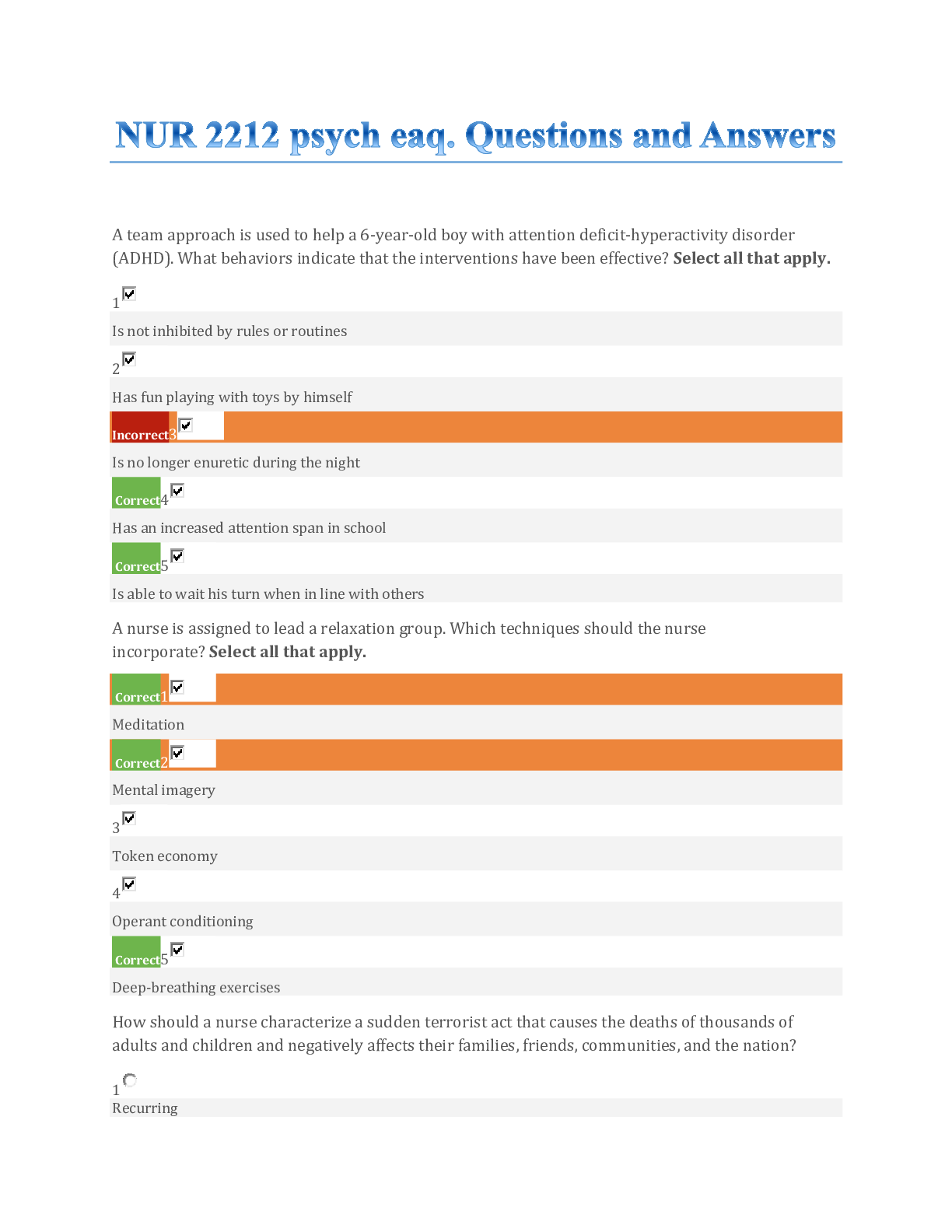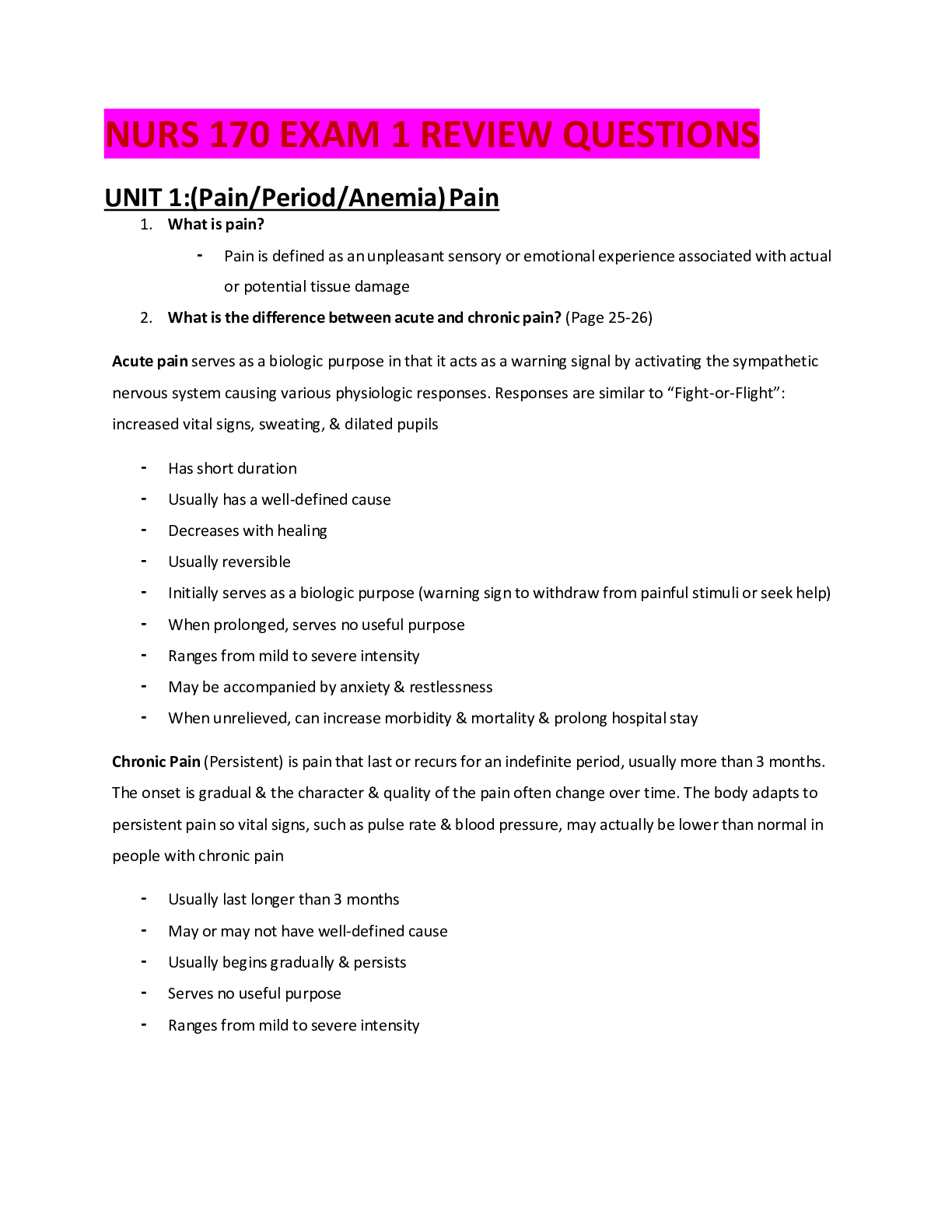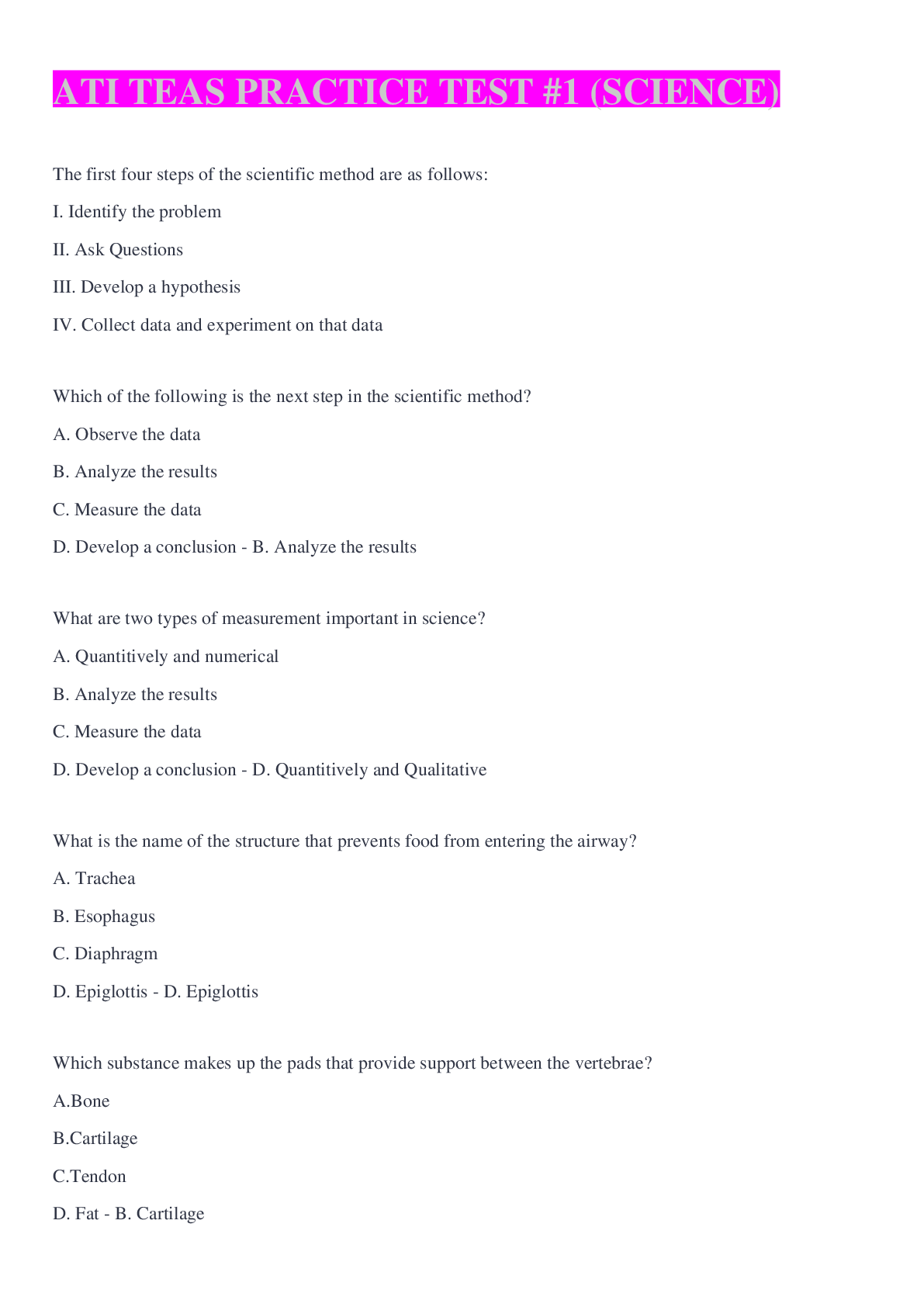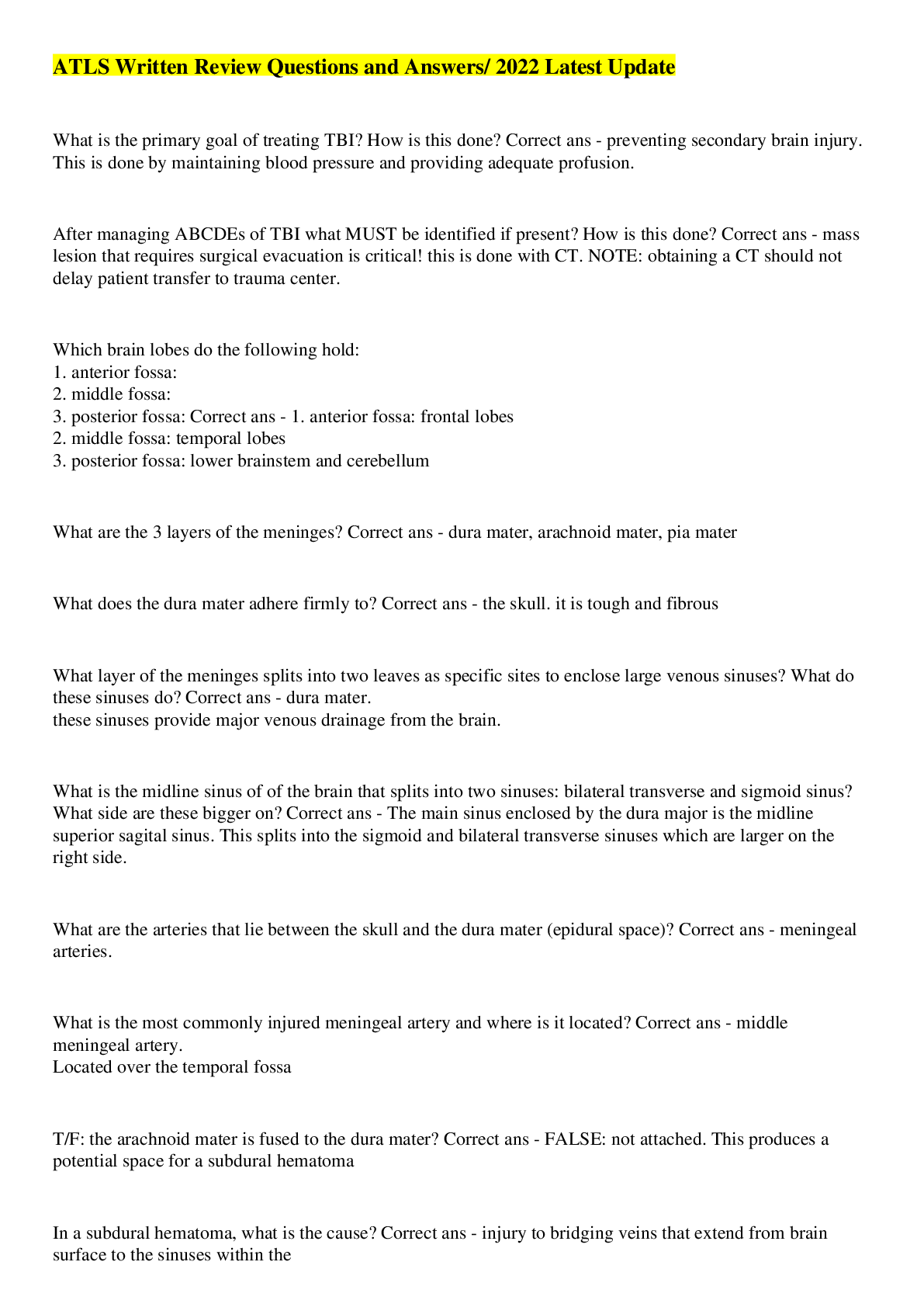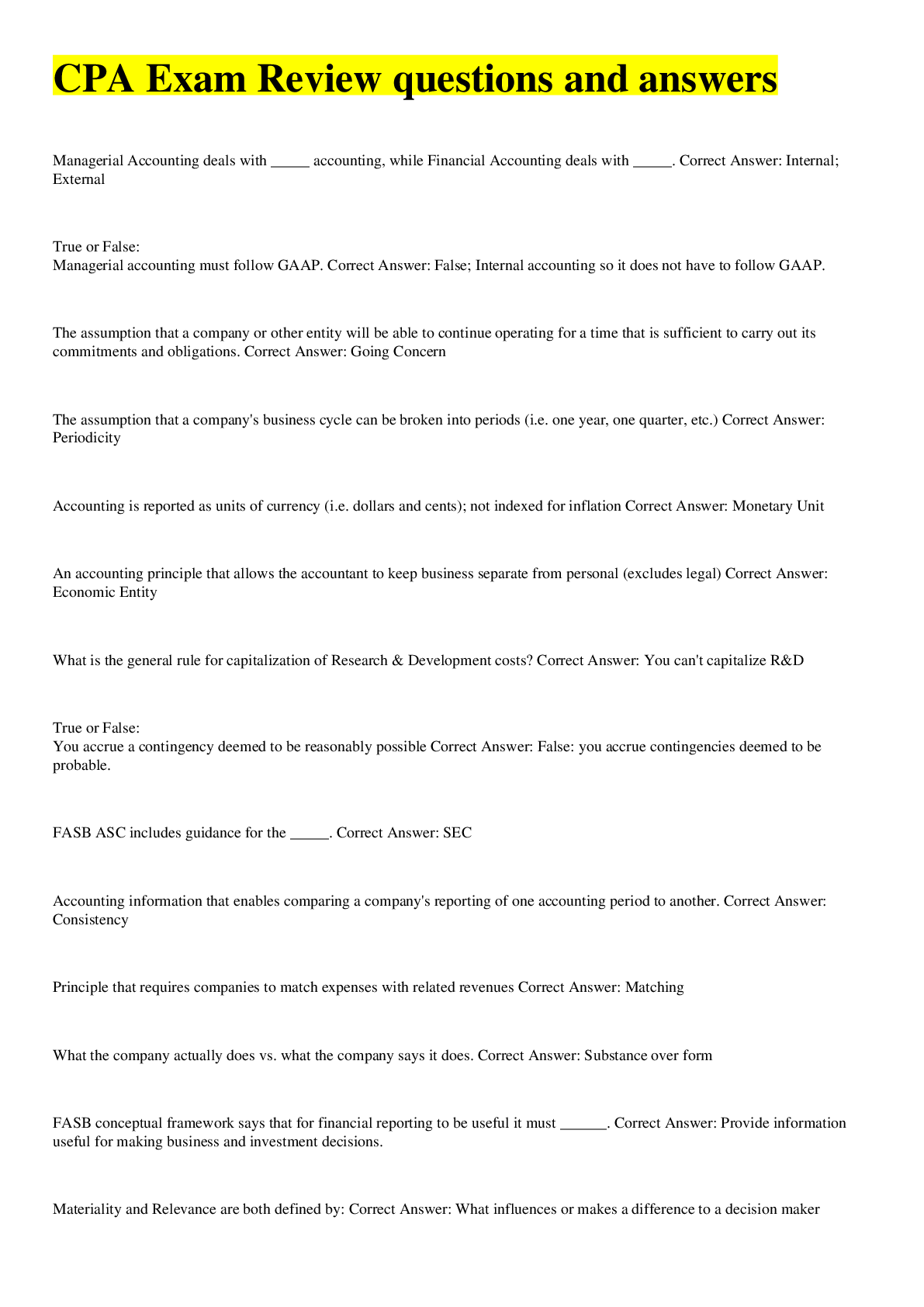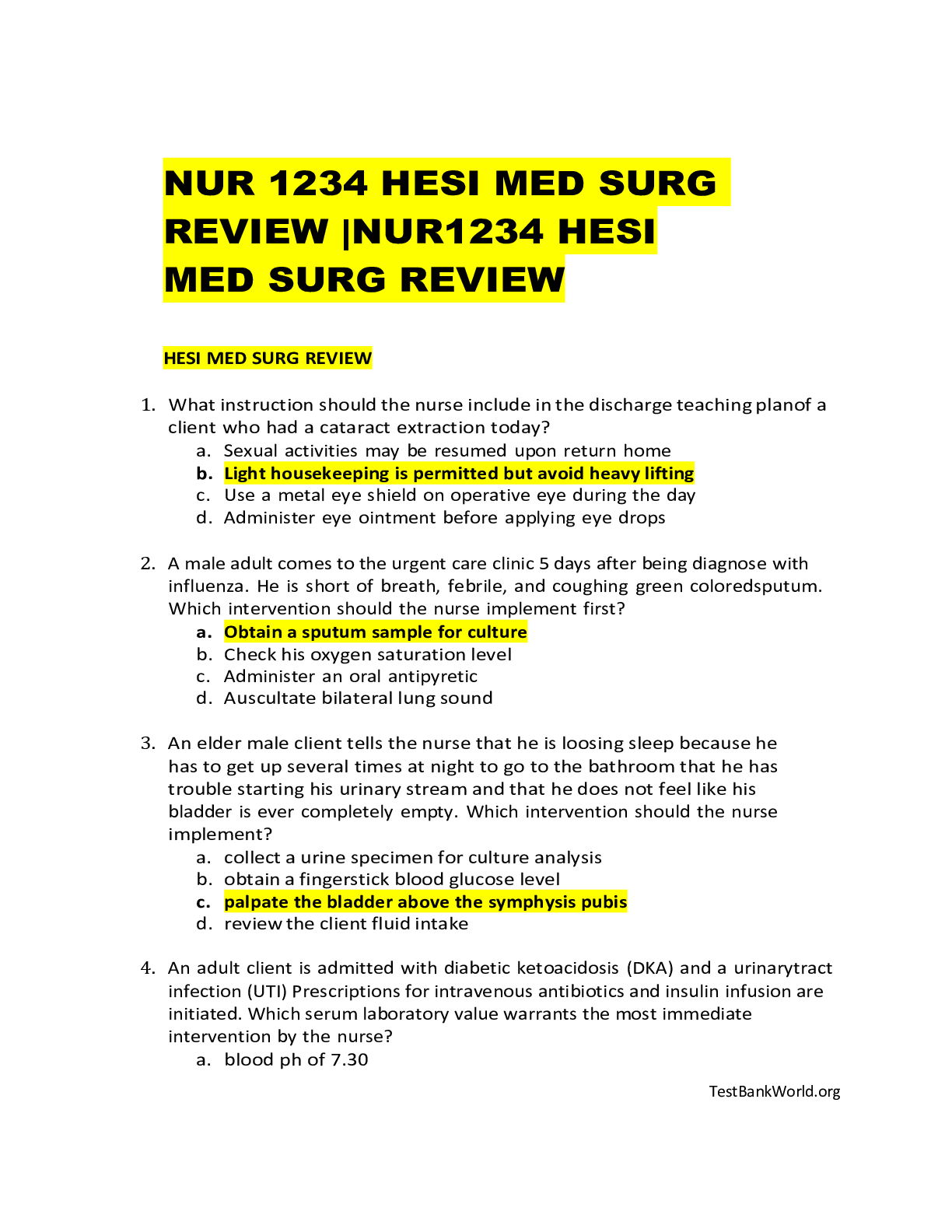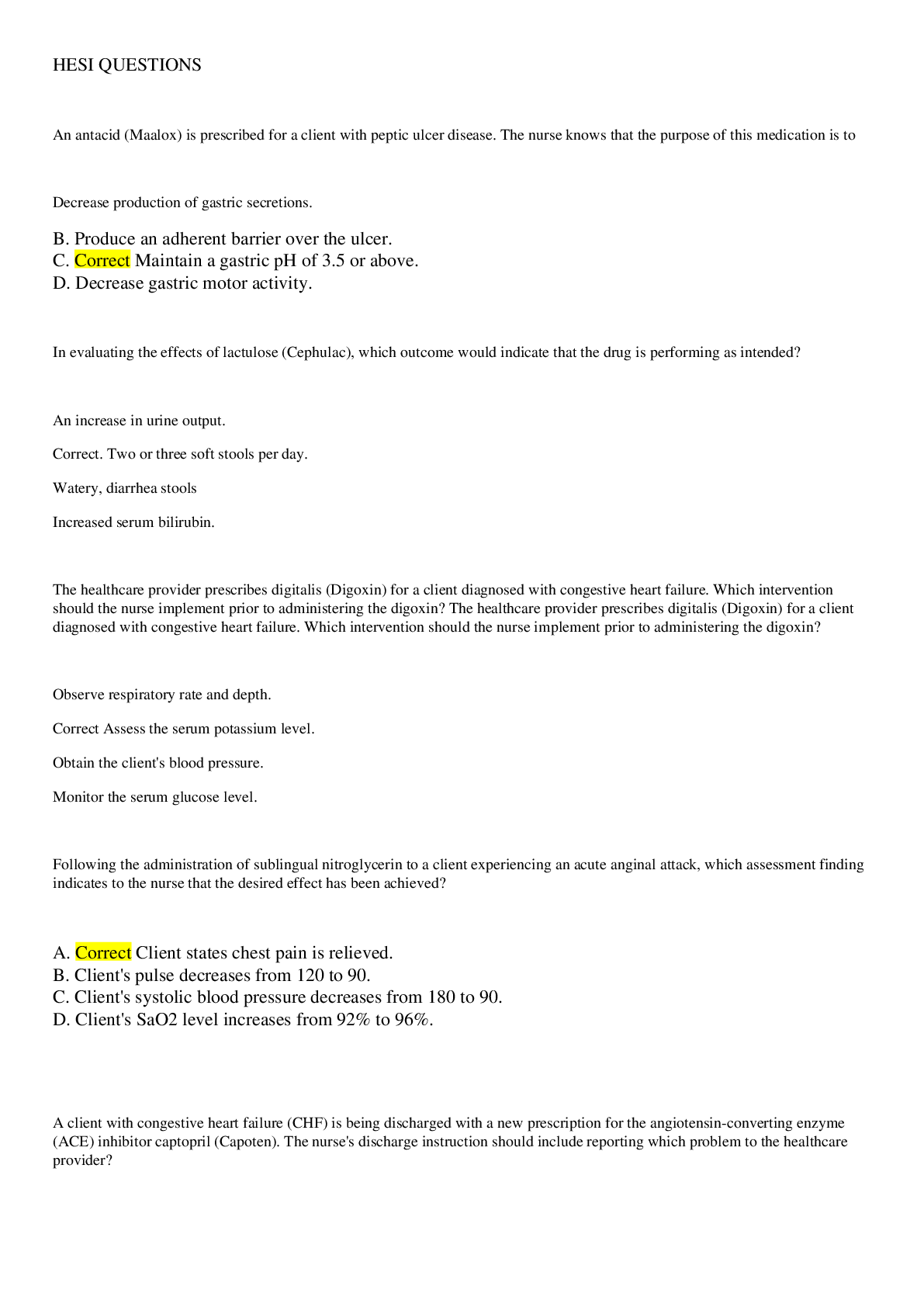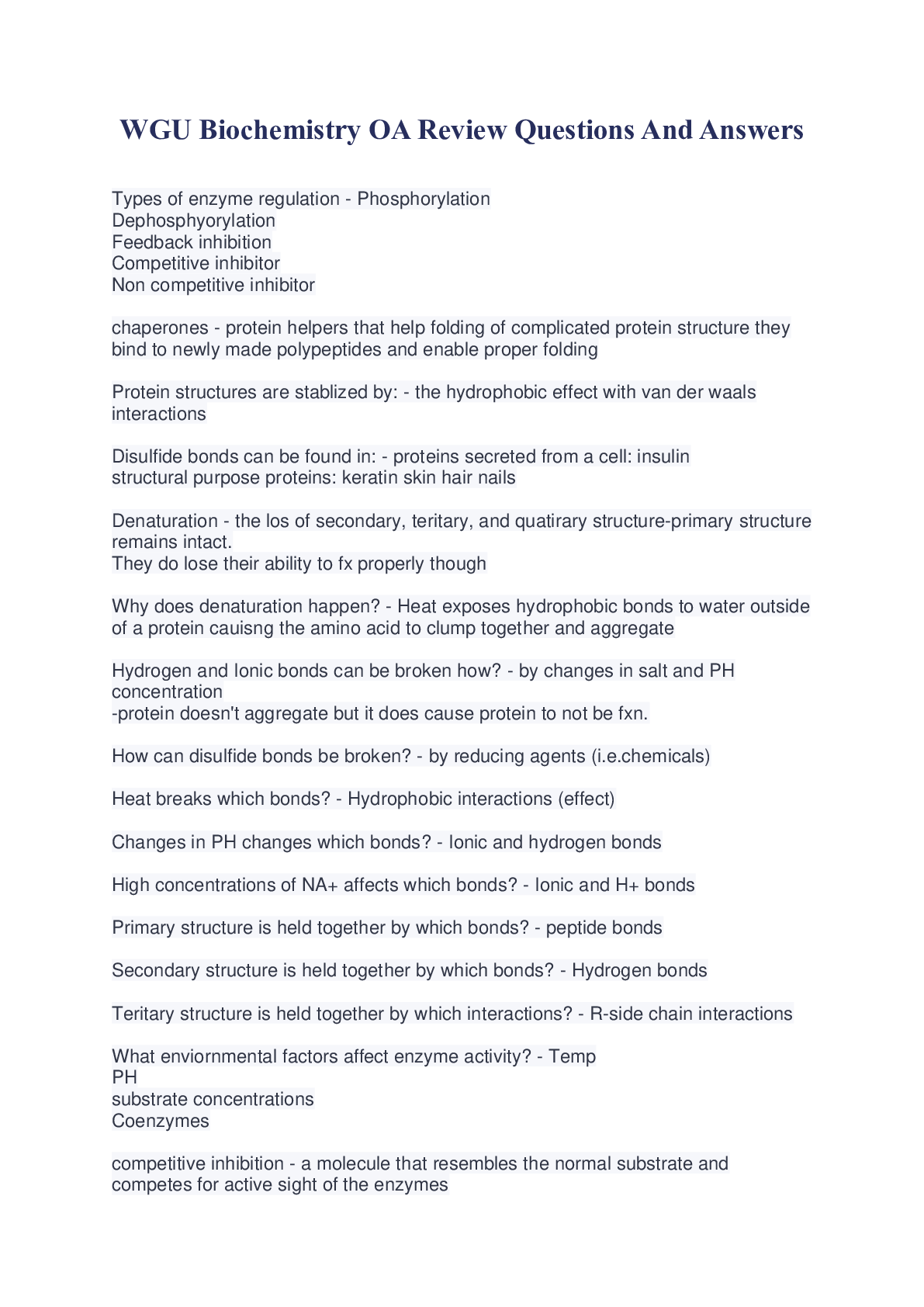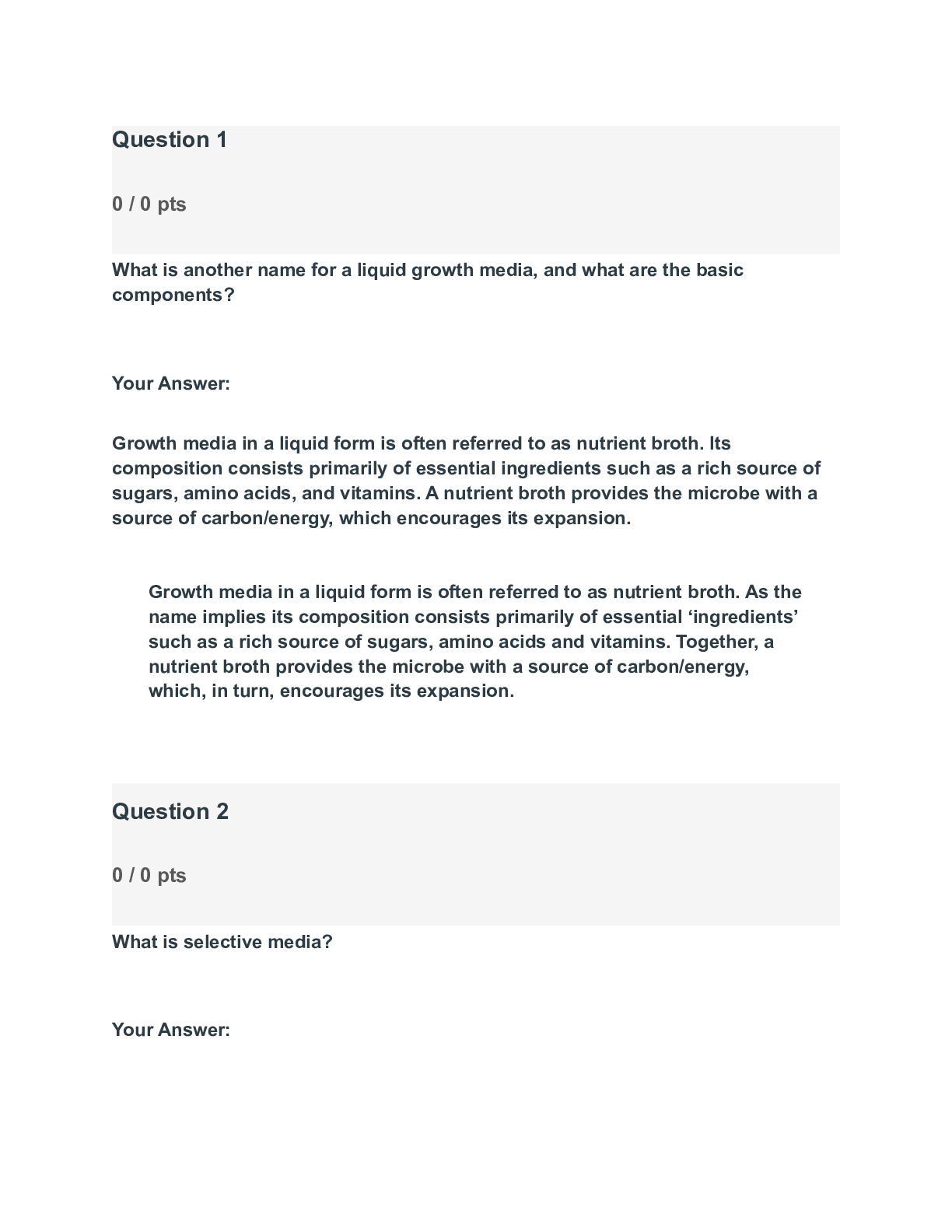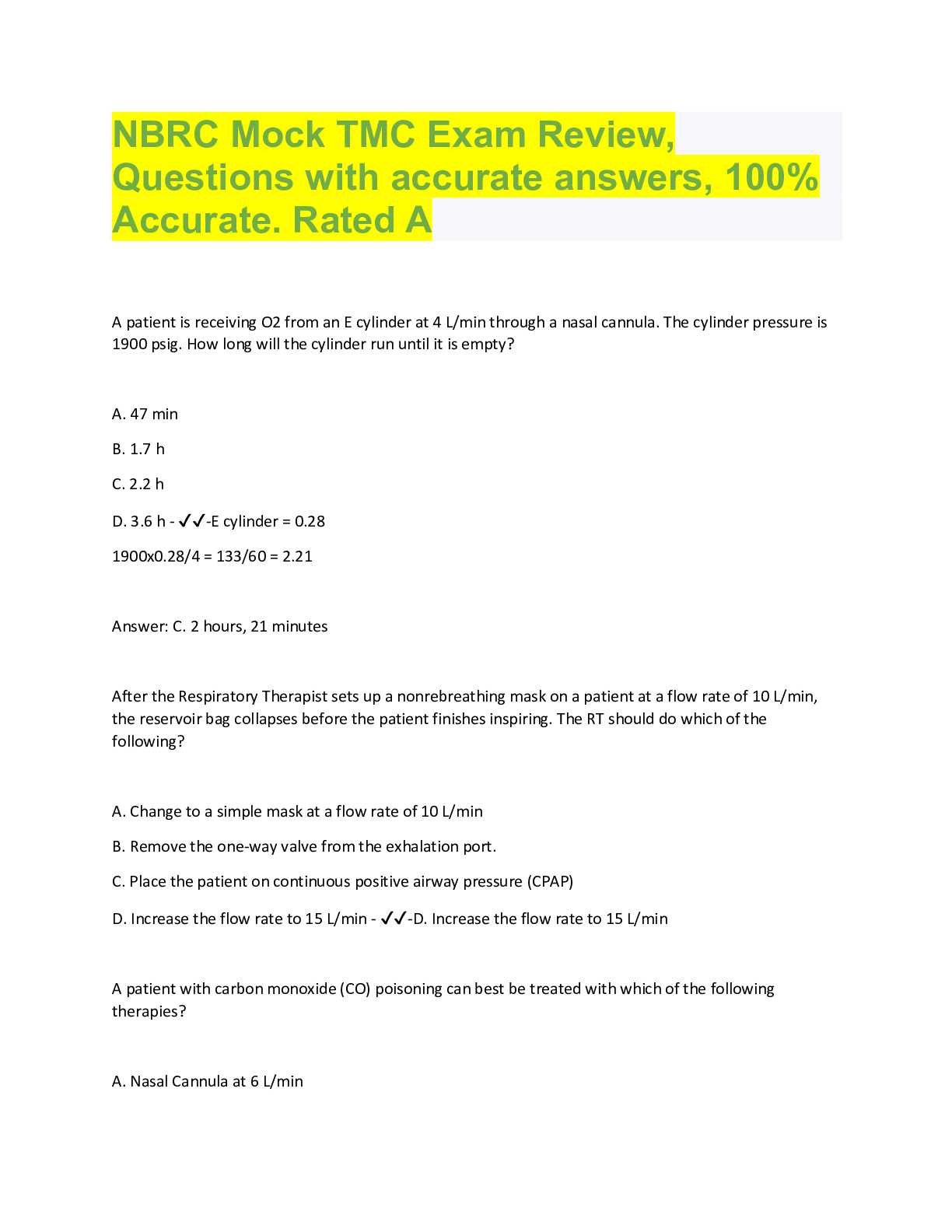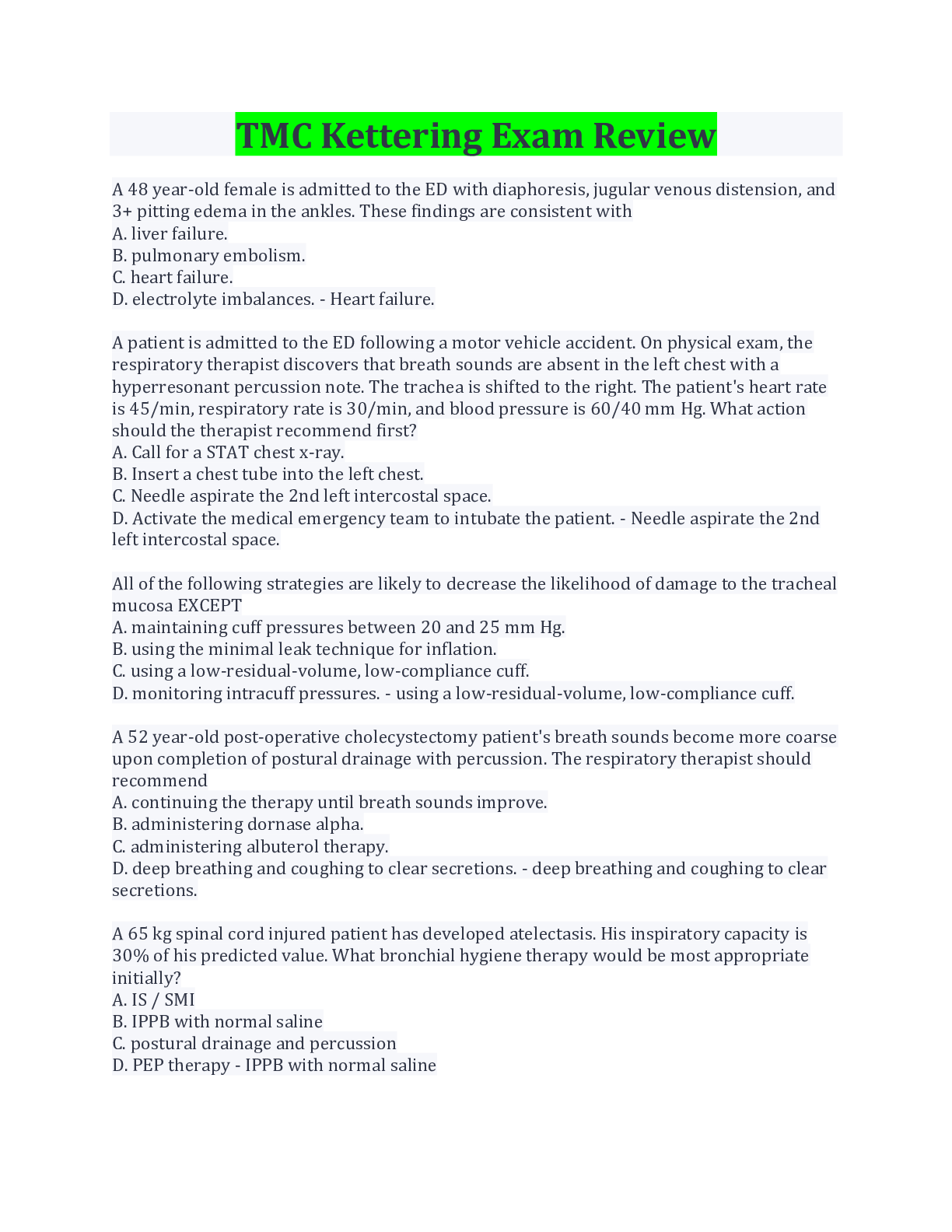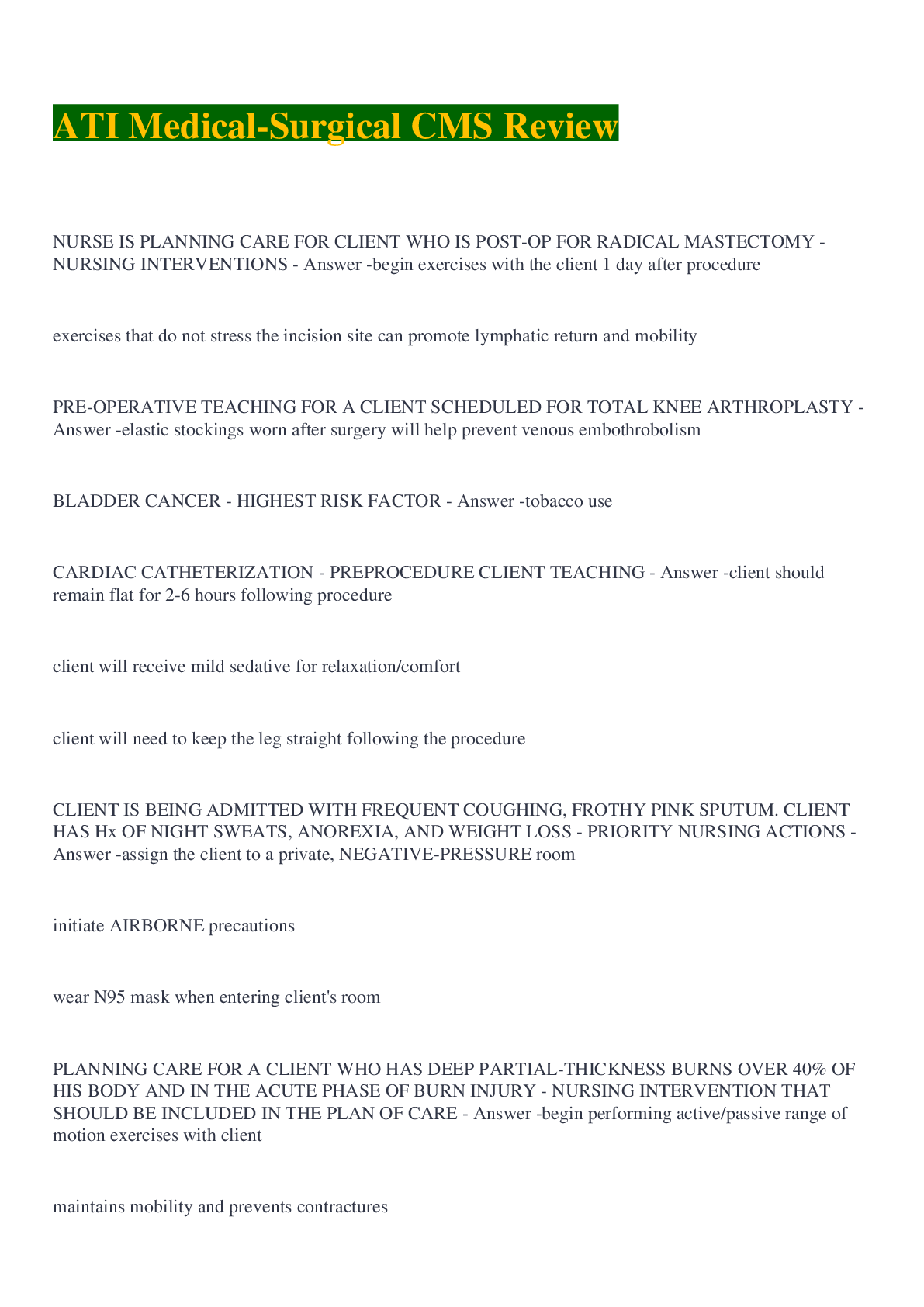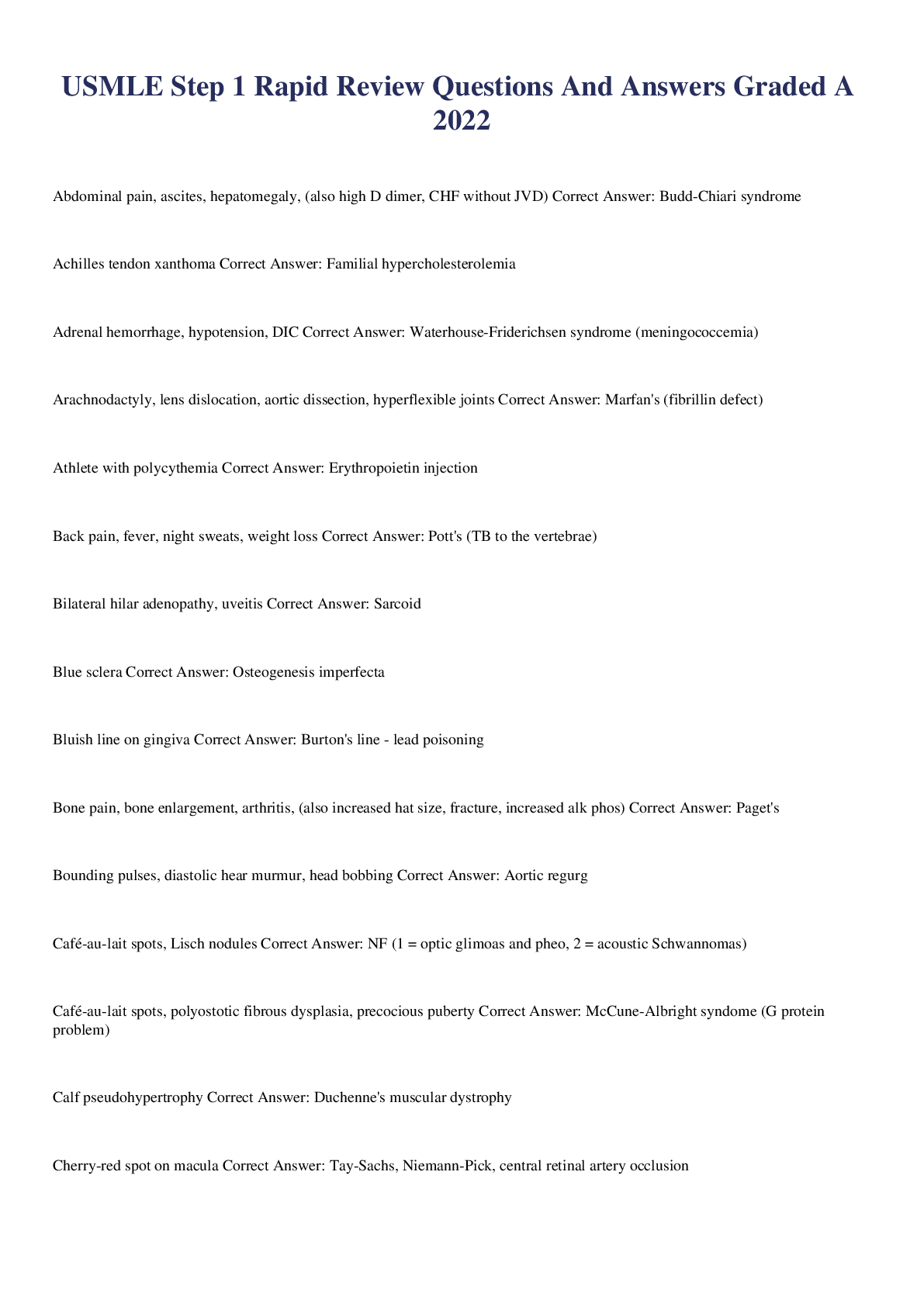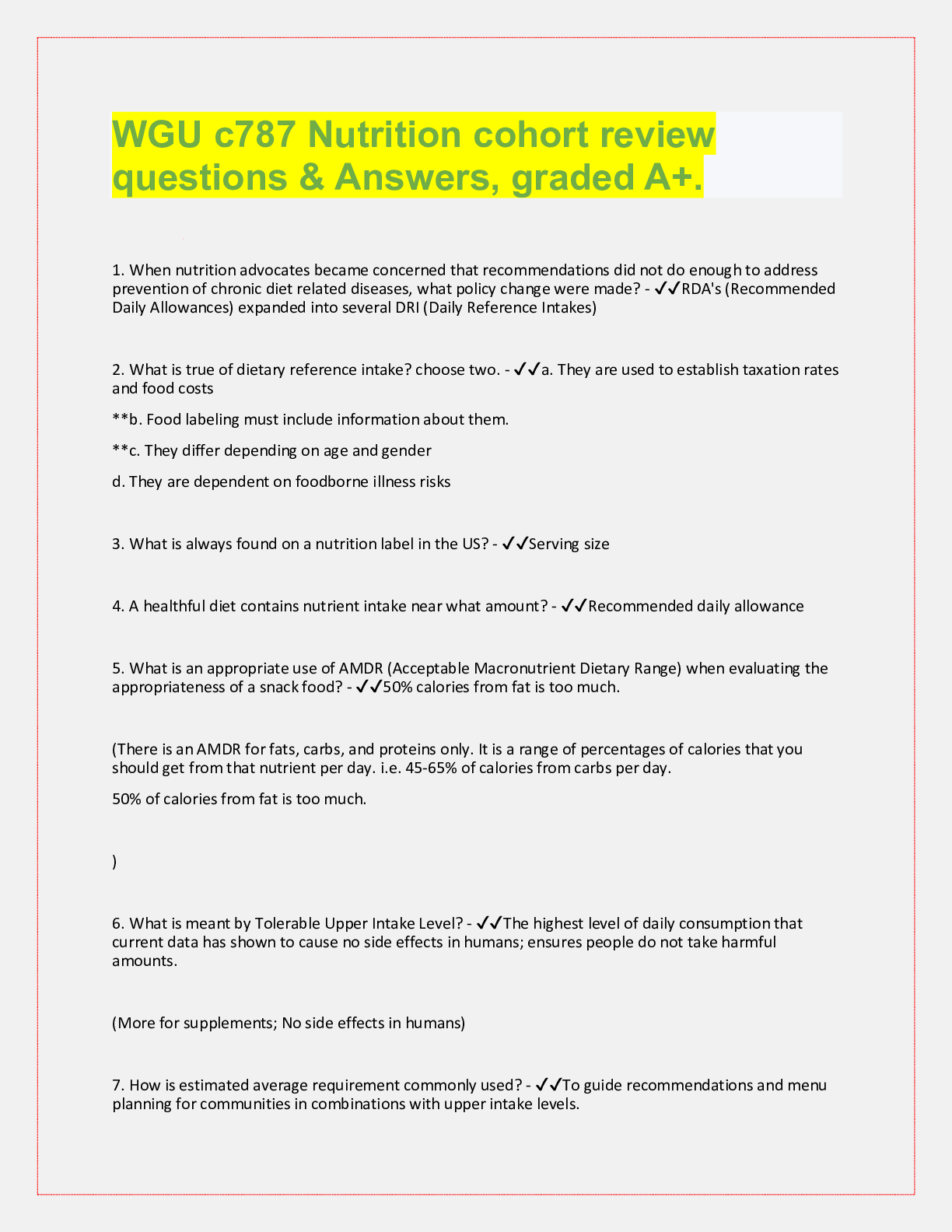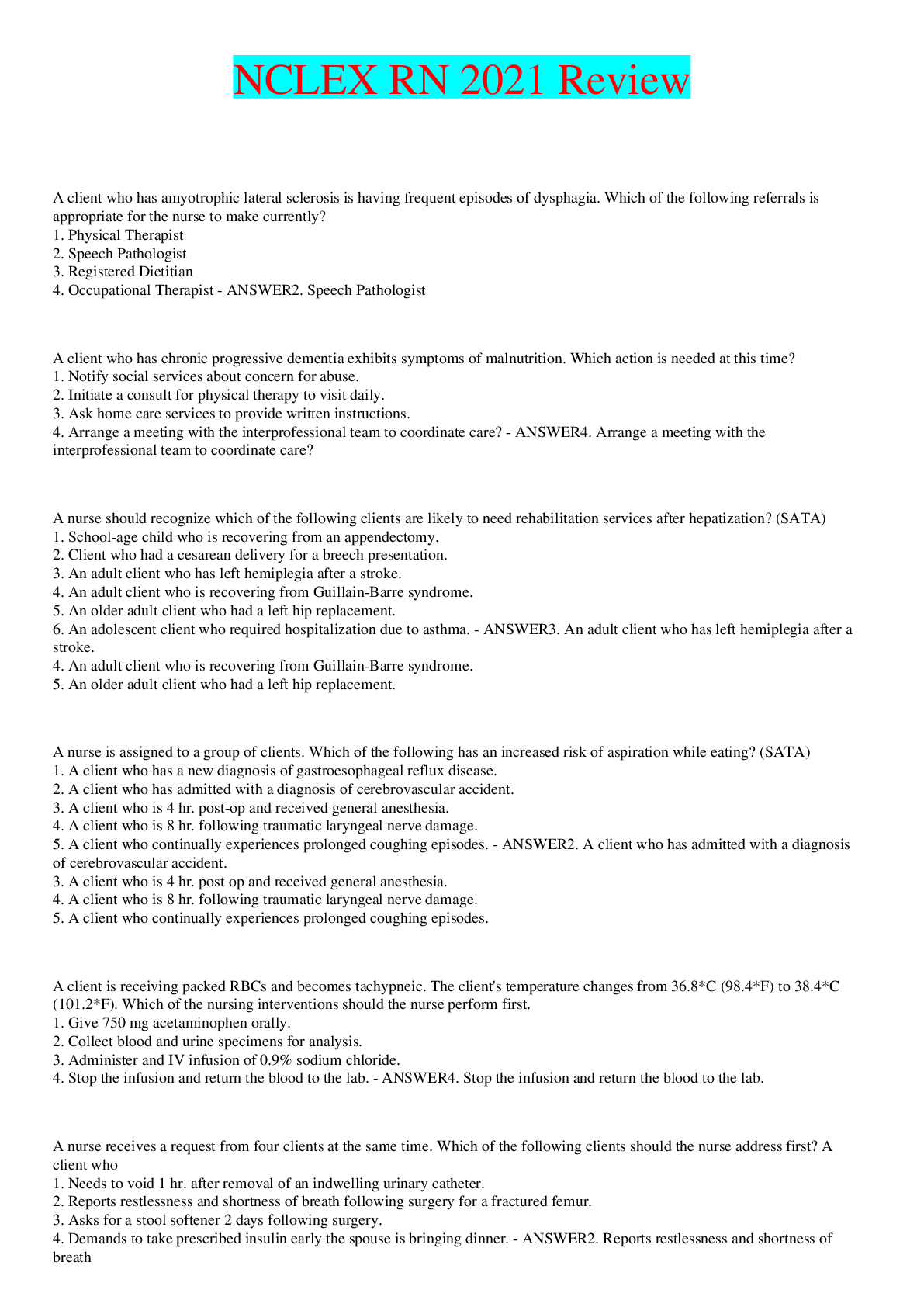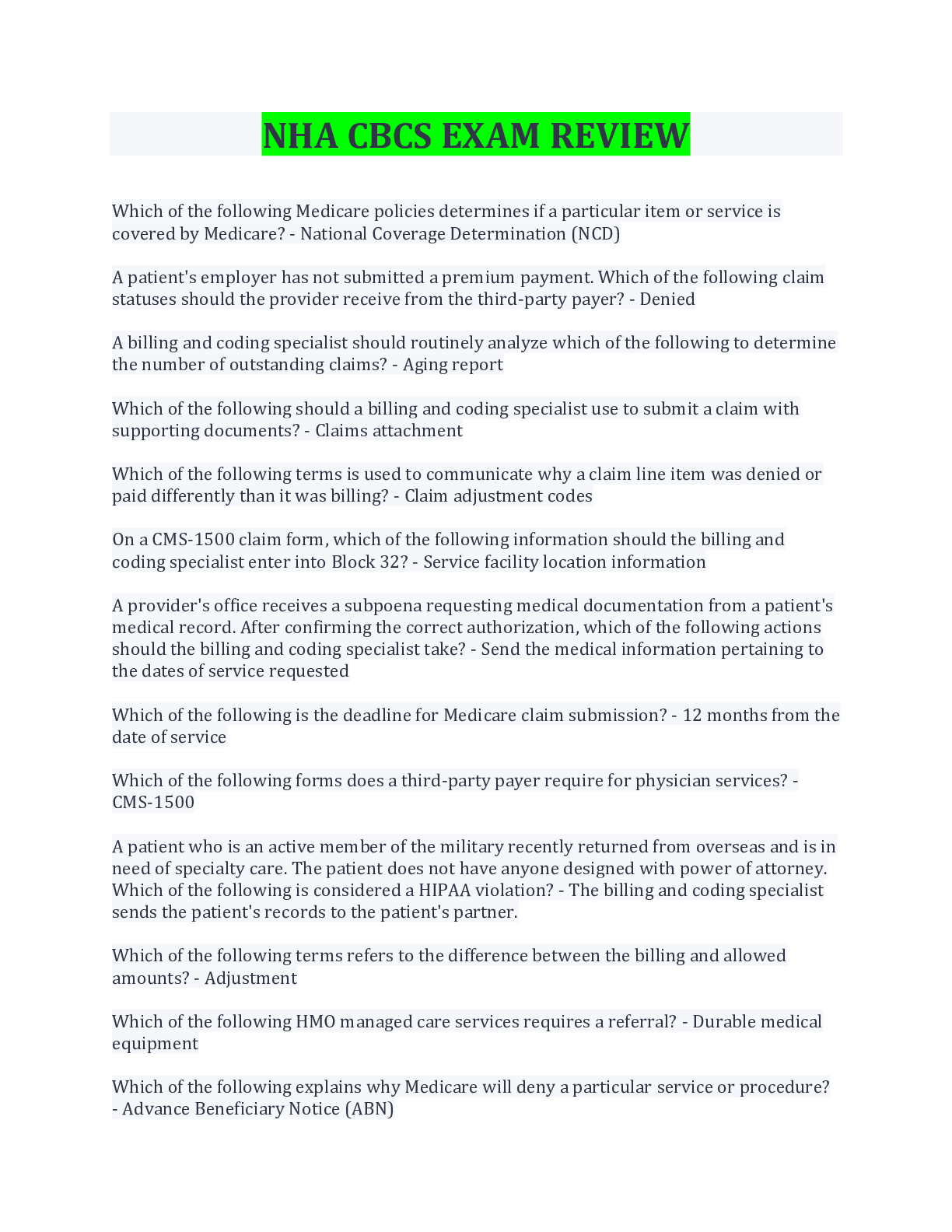NRSG 3302 - Test 2 Review Questions And Answers. Graded A. UPDATED
Document Content and Description Below
Review Questions 1. A 26 week gestation woman id diagnosed with severe preeclampsia. The nurse assess for which of the following signs/ symptoms associated with HELLP syndrome? a. Epigastric pain b. H... igh serum protein c. Hyporeflexia d. Thrombocytopenia e. Bloody stools 2. Client is being discharged from the hospital after evacuation of a molar pregnancy. The nurse recognizes that additional discharge teaching is required when the client states: a. “I am so sad for my loss” b. “I may need to have chemotherapy after this” c. “I will need to see the doctor in one year for a follow-up” d. “I will use contraception for the next year” 3. A patient who is having a difficult labor is diagnosed with cephalopelvic disproportion (CPD). The nurse should question which medical order: a. Maintain NPO status b. Start IV of Normal Saline c. Add 10 units of oxytocin to IV fluids – cesarean birth is indicated when there is a cephalopelvic disproportion, no need to induce labor may result in uterine rupture and fetal compromise d. Record fetal heart tones every 15 minutes 4. A client is admitted to the hospital with an ectopic pregnancy. The symptoms that caused her to seek health care is most likely to have been: a. Sharp unilateral abdominal pain b. Uncontrolled vomiting c. Lack of fetal movement d. Profuse vaginal bleeding 5. An increased risk for shoulder dystocia is associated with: a. Preterm labor b. Maternal diabetes c. VBAC d. Previous precipitous birth 6. A primigravida patient who is 29 weeks pregnant comes to the labor and delivery unit. She is O+ and rubella immune. She states she is having regular contractions every 8 minutes. An exam reveals she is 3 cm dilated. Which of the following can the nurse expect to administer? a. Folic acid b. Nifedipine c. Betamethasone d. Rhogram e. IV fluids f. Morphine 7. A 28 year old, G3G2 has just been diagnosed with gestational diabetes at 30 weeks. The client asks what types of complications may occur with this diagnosis. Which complications should the nurse identify as being associated with gestational diabetes? a. Maternal seizures b. Large for gestational age infant c. Hyperglycemia in the newborn d. Hypoglycemia in the newborn e. Fetal anemia 8. Which of the following is an indication to discontinue administration of magnesium sulfate in a women with preeclampsia? a. Blood pressure of 120/70 b. Nausea and vomiting c. Epigastric pain d. Respiratory rate of 10 9. When a breech presentation is suspected during the intrapartum period, a priority nursing interventions is to diligently observe the client for signs of: a. Hip dysplasia b. Cord prolapse c. A precipitous delivery d. Labor progression 10. A 34 year old with chronic hypertension arrives at the emergency department stating that she is in labor and complaining of constant pain between contractions. The nurse palpates a rigid abdomen with no signs of relaxation and concludes that the: a. fetus birth may be imminent b. patient may have abruptio placentae c. patient may have placenta previa d. fetus may be in the breech presentation 11. A patient is admitted in active labor with her second baby. Her prenatal record indicates she has a history of genital herpes. When performing the admission assessment, the nurse notes herpetic lesions on the genitalia confirmed by the physician, in order to shorten the second stage of labor: a. Done vaginally, with forceps and an episiotomy, to shorten the second stage of labor b. Preceded by 2 doses of antibiotics, to decrease transmission to the baby c. A cesarean birth, to prevent exposure of the baby to herpetic lesions d. A cesarean birth, to decrease maternal stress from the labor and minimize exacerbation of the herpes. 12. A client who is 3 months pregnant comes to the prenatal clinic because she is having some dark brown vaginal bleeding and experiencing severe nausea and vomiting. Her fundal height is larger than expected, there are no fetal heart tones auscultated. Which of the following complications should the nurse suspect? a. Hyperemesis gravidarum b. Threatened abortion c. Placenta previa d. Molar pregnancy 13. A sterile vaginal exam is contraindicated in: a. A patient with placenta previa b. A patient who is GBS+ (Group B Strep) c. A patient with ruptured membranes d. A patient in transition 14. A primigradida with pregesational type 1 diabeted is at her first prenatal visit. When discussing changes in insulin needs during pregnancy and birth, the nurse explains that based on her blood glucose levels she should expect to decrease her insulin dosage between the: a. 8th and 11th weeks of gestation b. 18th and 21st weeks of gestation c. 24th and 28th weeks of gestation- At the end of the second trimester and the beginning of the third trimester, insulin needs increase because of an increase in maternal resistance to insulin. During the earlier part of pregnancy, fetal demands for maternal glucose may cause a tendency toward hypoglycemia. During the last weeks of pregnancy, maternal resistance to insulin decreases and insulin needs decrease accordingly. d. 36th week of gestation and the time of birth 15. A baby is entering the pelvis in the vertex presentation with the posterior frontanel palpable near the mothers sacrum. The nurse determines that which of the following malpositions is consistent with this situation? a. LSP (left sacral posterior) b. ROP (right occiput posterior) c. LMA (left mentum anterior) d. RADA (right acromion dorsal anterior) 16. The nurse is planning care for the newborn. Which of the following nursing interventions would best protect the newborn from the most common form of heat loss? a. Placing the newborn away from air currents b. Pre-warming the examination table c. Drying the newborn thoroughly d. Removing wet linens from the isolate 17. The community nurse is working with poor women, who are formula-feeding their infants. Which statement indicates that the nurse’s education session was effective? a. “I should use only soy-based formula for the first year” b. “I follow the instructions for mixing the powdered formula exactly.” c. “I can reuse one bottle for several feedings” d. “The mixed formula can be left on the counter for a day” 18. Following delivery, the nurse would first assess which 2 newborn body systems that must undergo the most rapid changes to support extrauterine life? a. Gastrointestinal and hepatic b. Neurologic and temperature control c. Respiratory and cardiovascular d. Hematologic and cardiovascular 19. When caring for a newborn, the nurse must be alert for what potential sign of cold stress? a. Decreased activity level – newborns are unable to shiver as a means of heat production, they increase their activity level instead. b. Increased respiratory rate c. Appears to stop breathing for 5-10 sec while asleep d. Hyperglycemia – hypoglycemia would occur with cold stress 20. The student nurse notices that the newborn has the ability to ignore the constant crying of the other newborns in the newborn nursery. The nursing instructor explains that this newborn behavior is known as: a. Self-quieting behavior b. Orientation c. Habituation d. Active-alert state 21. During an assessment of a 12 hour old newborn the nurse notices pale pink spots on eyelids and forhead. The nurse documents this finding as: a. Nevus vasculosus – (strawberry mark) is a capillary hemangioma. b. Nevus flammeus – (port-wine stain) a capillary angioma, located directly below the epidermis c. Telangiectatic nevi – (stork bites) are pale pink or red spots that appear on the eyelids, nose, lower occipital bone, or the nape of the neck. d. A Mongolian spot- black pigmentation on the dorsal area of the buttocks 22. The nurse is making an initial assessment of the newborn. Which of the following data would be considered normal? a. Chest circumference 31.5 cm, head circumference 33.5 cm b. Chest circumference 30 cm, head circumference 29 cm c. Chest circumference 38 cm, head circumference 31.5 cm d. Chest circumference 32.5 cm, head circumference 36 cm 23. One minute after birth a baby girl was assessed to be crying strongly in a flexed position. Her heart rate was 110, and her body was pink with bluish hands and feet, She cried vigorously and turned away when her nares were suctioned. The nurse assigs an Apgar score of: a. 7 b. 8 c. 9 d. 10 24. The nurse known that in some cases, breastfeeding is not advisable. Which mother should counseled against breastfeeding? a. A mother with a poorly balanced diet b. A mother who is overweight c. A mother who is HIV positive d. A mother who has twins 25. Transitional physiology involves a change in the circulation pattern at birth. The placenta blood flow ceases and the lungs become the organ of gas exchange. Which of the following occur as part of this transition: a. The lungs expand b. Surfactant decreases lung compliance c. The ductus arteriosus and the foramen ovale remain open to facilitate circulation. d. The systemic vascular resistance decreases e. Pulmonary vascular resistance decreases 26. When caring for the newborn after a vaginal delivery, the nurse needs to be able to identify the respiratory changes that occur during the transition of the fetus to extrauterine life. Which factors contribute to the baby transitioning from a fluid filled environment to breathing independently after birth? a. An increase in circulating prostaglandin levels b. Marked deceases in pulmonary circulation c. Inspiratory gasp triggered by the elevation in PCO2 and decreases in pH and PO2 d. Stimulation of skin nerve endings due to chilling e. Chemical stimulator associated with transient asphyxia of the fetus 27. The nurse anticipates that a newborn male, estimated to be 39 weeks gestation, would exhibit which characteristic? a. The ability to move his elbow past the sternum- would not have the ability to move elbow past midline b. Extended posture at rest- good muscle tone will result in a more flexed posture when at rest c. Testes descended into the scrotum- full tern infant will have both testes in his scrotum and rugae on his scrotum d. Abundant lanugo over his entire body – only moderate amount of lanugo, usually on his shoulder and back 28. The nurse is caring for 4 newborns, who have recently been admitted to the newborn nursery. Which labor event puts the newborn at risk for an alteration of health? The infant’s mother had: a. Ruptured membranes for 36 hours b. An IV of Lactated Ringer’s solution c. A labor that lasted 12 hours d. A cesarean birth with her last child 29. A Moro reflex is the single best assessment of the neurologic ability in a newborn. Unit protocols should specify what action for eliciting a Moro reflex? a. Turn her onto her abdomen and see if she can turn her head. b. Stroke the sole of the foot and look for the toes to fan out c. Lift her head while she is supine and allow it to fall back 1 inch d. Vigorously shake the newborns bassinette until she responds by flaring her arms out. 30. Which of the following findings on a newborn nursing assessment would warrant a call to the newborn’s pediatrician? a. /newborn’s breast tissue slightly engorged b. Heart rate of 180 bpm c. Respiratory rate of 75 bpm – ABC’s have priority d. Presence of milia on the nose A nurse must give vitamin K 0.5 mg IM to a newly born baby. Which of the following needles could the nurse safely choose for the injection? 1.5/8 inch, 18 gauge 2.5/8 inch 25 gauge 3.1 inch, 18 gauge 4.1 inch, 25 gauge ● The nurse notes that a newborn, who is 5 minutes old, exhibits the following characteristics: HR 108 bpm, respiratory rate 29 rpm with a lusty cry, pink body with bluish hands and feet, some flexion. What does the nurse determine the baby’s Apgar Score is? 1.6 2.7 3.8 4.9 ● A 2-day old breastfeeding baby born via normal spontaneous vaginal delivery has just been weighed in the newborn nursery. The nurse determines that the baby has lost 2.5% of the birth weight. Which of the following nursing actions is appropriate? 1.Do nothing because this is normal weight loss 2.Notify the neonatologist of the significant weight loss 3.Advise the mother to bottle feed the baby at the next feed 4.Assess the baby for hypoglycemia with a glucose monitor A nurse is doing a newborn assessment on a new admission to the nursery. Which of the following actions should the nurse make when evaluating the baby for developmental dysplasia of the hip? Select all that apply 1.Grasp the baby’s thighs with the thumbs on the innter thighs and forefingers on the outer thighs 2.Gently adduct the baby’s thigs 3.Palpate the trochanter to sense changes during hip rotation 4.Place the baby in a prone position 5.Flex the baby’s hips and knees at 90 degree angles ● A neonate is being admitted to the well-baby nursery. Which of the following findings should be reported to the neonatologist? 1.Umbilical cord with three vessels 2.Diamond shaped anterior fontanelle 3.Cryptorchidism – undescended testes (prematurity) 4.Café au lait spot ● To check for the presence of Epstein’s pearls, the nurse should assess which part of the neonate’s body? 1.Feet 2.Hands 3.Back 4.Mouth – small white specks located on palate and gums The nurse is performing a postpartum assessment on a client who delivered 4 hours ago. The nurse notes a firm fundus at the umbilicus with heavy lochial flow. Which of the following nursing actions is appropriate? 1.Massage the fundus 2.Notify the obstetrician 3.Administer oxytocin 4.Assist the client to the bathroom To prevent infection, the nurse teaches the postpartum client to perform which of the following tasks? 1.Apply antibiotic ointment to the perineum daily 2.Change the peripad at each voiding 3.Void at least every 2 hours 4.Spray the perineum with a povidone-iodine solution after toileting A client is 40 minutes postpartum from a forceps (causes trauma) delivery of a 4500 gram (large baby) neonate over a right mediolateral episiotomy (bleeding). The client is at risk for each of the follow nursing diagnoses. Which of the diagnoses is highest priority at this time? 1.Ineffective breast feeding 2.Fluid Volume Deficit- risk for hemorrhage – most life threatening- at least 3 risk factors: forceps, large baby, episiotomy. 3.Infection 4.Pain A woman’s temperature has just risen 0.4 degrees F and will remain elevated for the remainder of her cycle. What hormone is responsible for the temperature elevation? 1.Estrogen 2.Progesterone 3.LH 4.FSH Which of the following findings would the nurse determine are presumptive/ subjective signs of pregnancy? Select all that apply. 1.Amenorrhea- haven’t had a period 2.Breast tenderness 3.Quickening 4.Frequent urination 5.Uterine growth A women has a family history of Tay-sachs and wants to know if her baby could be born with the disease. What is the earliest test that could be done to determine this? 1.CVS- 1st trimester 2.Amniocentesis- 2en trimester/chromosomal abnormalities and again for lungs(3rd trim) 3.MSAFP- for neural tube defects 4.Ultrasound A G2P2002 client was examined 5 minutes ago. Her cervix was 8cm dilated and 90% effaced. She now states that she needs to move her bowels. Which of the following actions should the nurse perform first? 1.Offer the client the bedpan – if after exam she was still the same I could do this 2.Evaluate the progress of labor – does she need to poop or is the baby on the way 3.Notify the physician 4.Encourage the client to push The nurse auscultates a fetal HR of 152 on a client in early labor. Which of the following actions by the nurse is appropriate? 1.Inform the mother that the rate is normal 2.Reassess in 5 minutes to verify the results 3.Immediately report the rate to the HCP 4.Place the client on her left side and apply oxygen by face mask A women is in the transition phase of labor. Which of the follow comments should the nurse expect to hear? 1.I am so excited to be in labor 2.I can’t stand this pain any longer 3.I need ice chips because I am so hot 4.I have to push the baby out right now. A newly diagnosed insulin dependent diabetic, with good blood sugar control at 20 weeks gestation, asks how her diabetes will affect her baby. The best explanation would include: A. Your baby may be smaller than average at birth. – if uncontrolled blood sugar B. Your baby may be larger than average at birth. C. As long as you control your blood sugar, your baby won’t be affected D. Your baby might have high blood sugar for several days – would be opposite The nurse is assessing a pregnant client with type 1 DM about her understanding regarding changing insulin needs during pregnancy. The nurse determines that further teaching is needed if the client makes what statement? A. I will increase my insulin dosage for the first 3 months of pregnancy. Will actually decrease in 1st trimester B. My insulin dose will likely increase during the second and third trimesters. C. Episodes of hypoglycemia are more likely to occur during the first 3 months of pregnancy. D. My insulin needs should return to normal w/in 7 – 10 days after birth if I’m bottle feeding. A pregnant client has mild preeclampsia, which assessment finding indicates worsening preeclampsia and the need to notify the physician? A. Increased urinary output B. Dependent edema has resolved C. BP is at the prenatal baseline D. Patient complains of headache and blurred vision A 26-week gestation woman is diagnosed with severe preeclampsia with HELLP syndrome. The nurse will assess for which of the following s/s? A. Low serum creatinine B. High serum protein C. Bloody stools D. Epigastric pain The nurse is assessing a pregnant client in the second trimester with was admitted with suspected abruptio placentae. Which assessment finding would the nurse expect to note if the condition is present? A. Soft abdomen B. Uterine tenderness C. Absence of abdominal pain D. Painless, bright red vaginal bleeding The maternity nurse is preparing for the admission of a client in the 3rd trimester who is experiencing vaginal bleeding and has a suspected diagnosis of placenta previa. Which prescription should the nurse question? A. Ultrasound B. Manual pelvic exam C. H&H blood sample D. FHR monitoring The nurse is performing an initial assessment on a client who has just been told that a pregnancy test is positive. Which assessment finding indicates that the client is as risk for preterm labor? A. Client is 30 yo and primigravida B. Client has a history of smoking a pack a day - nocotine vasoconstricts- less blood flow to baby C. Client’s hemoglobin level is 13.5 g/dL D. The client is a 20 yo primigravida of average weight and height The nurse in a newborn nursery is monitoring a preterm newborn for respiratory distress syndrome. Which assessment findings would alert the nurse to the possibility of this syndrome? A. Tachypnea and retractions B. Acrocyanosis and grunting C. Hypotension and bradycardia D. Presence of a barrel chest and acrocyanosis The nurse assessing a newborn who was born to a mother who is addicted to drugs. Which assessment finding would the nurse expect to note during the assessment of this newborn? A. Lethargy B. Sleepiness C. Constant crying D. Cuddles when being held The nurse is preparing to care for a newborn receiving phototherapy. Which interventions should be included in the plan of care? Select all that apply. A. Avoid stimulation B. Decrease fluid intake C. Expose all the newborn’s skin D. Monitor skin temp closely E. Reposition newborn every 2 hours F. Cover the newborn’s eyes with shields or patches A G2P2002 client was examined 60 minutes ago. Her cervix was 4cm dilated and 50% effaced. She now states that she needs to move her bowels. Which of the following actions should the nurse perform first? 1.Offer the client the bedpan 2.Evaluate the progress of labor 3.Notify the physician 4.Encourage the client to push The nurse places the FHR monitor and notes the HR is 74bpm. What is the first thing the nurse should do? 1.Inform the mother that the rate is normal 2.Immediately report the rate to the HCP 3.Place the client on her left side and apply oxygen by face mask 4.Assess the mother’s heart rate A women, who is in labor, is in her hospital bed calmly talking to her husband. They are both excited the baby is on its way. What stage of labor would you expect this mother to be in. 1.Latent 2.Active 3.First 4.Second The nursery nurse is careful to wear gloves when admitting neonates into the nursery. Which of the following is the scientific rationale for this action? 1. Meconium is filled with enteric bacteria. 2. Amniotic fluid may contain harmful viruses. 3. The high alkalinity of fetal urine is caustic to the skin. 4. The baby is high risk for infection and must be protected. A mother who just delivered 24 hours ago notices a red rash with yellow pustules on her newborn’s face and asks the nurse if she should be concerned. What would you tell the mother? 1.These spots are called stork bites and will disappear around the time your baby is 2 years old. 2.The pediatrician should see the rash as it could indicate infection 3.The rash is called erythema toxicum, and it is normal and should disappear within a week. 4.That is a port-wine stain and your baby will have it for the rest of its life. The nurse is discussing the neonatal blood screening test with a new mother. The nurse knows that more teaching is needed when the mother states that which of the following diseases is included in the screening test? 1. Hypothyroidism. 2. Sickle cell anemia. 3. Galactosemia. 4. Cerebral palsy. The nurse notes that a newborn, who is 5 minutes old, exhibits the following characteristics: HR 98 bpm, respiratory rate 35 rpm with a lusty cry, pink body with bluish hands and feet, full flexion. What does the nurse determine the baby’s Apgar Score is? 1.6 2.7 3.8 4.9 ● The nurse is about to elicit the Moro reflex. Which of the following responses should the nurse expect to see? 1. When the cheek of the baby is touched, the newborn turns toward the side that is touched. - Rooting 2. When the lateral aspect of the sole of the baby’s foot is stroked, the toes extend and fan outward. - Babinski 3. When the baby is suddenly lowered or startled, the neonate’s arms straighten outward and the knees flex. 4. When the newborn is supine and the head is turned to one side, the arm on that same side extends. – tonic During a prenatal interview, a client tells the nurse, “My mother told me she had toxemia during her pregnancy and almost died!” Which of the following questions should the nurse ask in response to this statement? 1. “Does your mother have a cardiac condition?” 2. “Did your mother tell you what she was toxic from?” 3. “Does your mother have diabetes now?” 4. “Did your mother say whether she had a seizure or not?” A client who is 18 weeks’ gestation has been diagnosed with a hydatiform mole (gestational trophoblastic disease). In addition to increased uterine growth, which of the following signs/symptoms would the nurse expect to see? 1. Hyperemesis and hypertension. - increased serum beta-hCG levels, increased size of the uterus related to gestational age, nausea and vomiting, and evidence of vaginal bleeding. Development of preeclampsia earlier in the pregnancy would be noted, resulting in hypertension, not hypotension. 2. Diarrhea and hyperthermia. 3. Polycythemia. 4. Polydipsia. A woman has just been admitted to the emergency department subsequent to a head-on automobile accident. Her body appears to be uninjured. The nurse carefully monitors the woman for which of the following complications of pregnancy? 1. Placenta previa. 2. Transverse fetal lie. 3. Placental abruption. 4. Severe preeclampsia. A nurse is caring for four prenatal clients in the clinic. Which of the clients is high risk for placenta previa? 1. Jogger with low body mass index. 2. Smoker carrying fraternal triplets. 3. Registered professional nurse. 4. Police officer on foot patrol. A baby’s blood type is B negative. The baby is at risk for hemolytic jaundice if the mother has which of the following blood types? 1. Type O negative. 2. Type A negative. 3. Type B positive. 4. Type AB positive. A 42-week-gestation baby has been admitted to the neonatal intensive care unit. At delivery, thick green amniotic fluid was noted. Which of the following actions by the nurse is critical at this time? 1. Bath to remove meconium-contaminated fluid from the skin. 2. Ophthalmic assessment to check for conjunctival irritation. 3. Rectal temperature to assess for septic hyperthermia. 4. Respiratory evaluation to monitor for respiratory distress. A baby has been admitted to the neonatal nursery whose mother is hepatitis B–surface antigen positive. Which of the following actions by the nurse should be taken at this time? 1. Monitor the baby for signs of hepatitis B. 2. Place the baby on contact isolation. 3. Obtain an order for the hepatitis B vaccine and the immune globulin. 4. Advise the mother that breastfeeding is absolutely contraindicated. A woman, 26 weeks’ gestation, has just delivered a fetal demise. Which of the following nursing actions is appropriate at this time? A. Remind the mother that she will be able to have another baby in the future. B. Dress the baby in a tee shirt and swaddle the baby in a receiving blanket. C. Ask the woman if she would like the doctor to prescribe a sedative for her. D. Remove the baby from the delivery room as soon as possible. A woman has a history of toxic shock syndrome. She should be taught to avoid which of the following forms of birth control? A. Diaphragm. – risk of TSS (tampons) B. Intrauterine device. C. Birth control pills (estrogen-progestin combination). D. Depo-Provera (medroxyprogesterone acetate). A 19-year-old client with multiple sex partners is being counseled about the hepatitis B vaccination. During the counseling sessions, which of the following should the nurse advise the client to receive? A. The hepatitis B immune globulin before receiving the vaccine. (newborn who mothers are Hep B +) B. A vaccine booster every 10 years. (tetnus) C. The complete series of three intramuscular injections. D. The vaccine as soon as she becomes 21. A woman has been diagnosed with primary syphilis. Which of the following physical findings would the nurse expect to see? a. Cluster of vesicles b. Pain-free lesion c. Macular rash – secondary along with lesions d. Foul-smelling discharge The nurse is educating a group of adolescent women regarding STIs. The nurse knows that learning was achieved when a group member states that the most common sign/symptom of STIs is which of the following? a. Menstrual cramping b. Heavy menstrual periods c. Flu-like symptoms d. Lack of signs or symptoms A 14-year-old girl and her mother go to her yearly checkup at the pediatrician’s office. The nurse wants to offer a new vaccine against the human papilloma virus. Why is it important for the client to receive this vaccine? a. The human papilloma virus is spread through casual contact in schools. b. There is only one type of human papilloma virus that infects the genital tract. c. The human papilloma virus is found exclusively in genital warts. d. The human papilloma virus is associated with cervical dysplasia and cancer. [Show More]
Last updated: 1 year ago
Preview 1 out of 15 pages
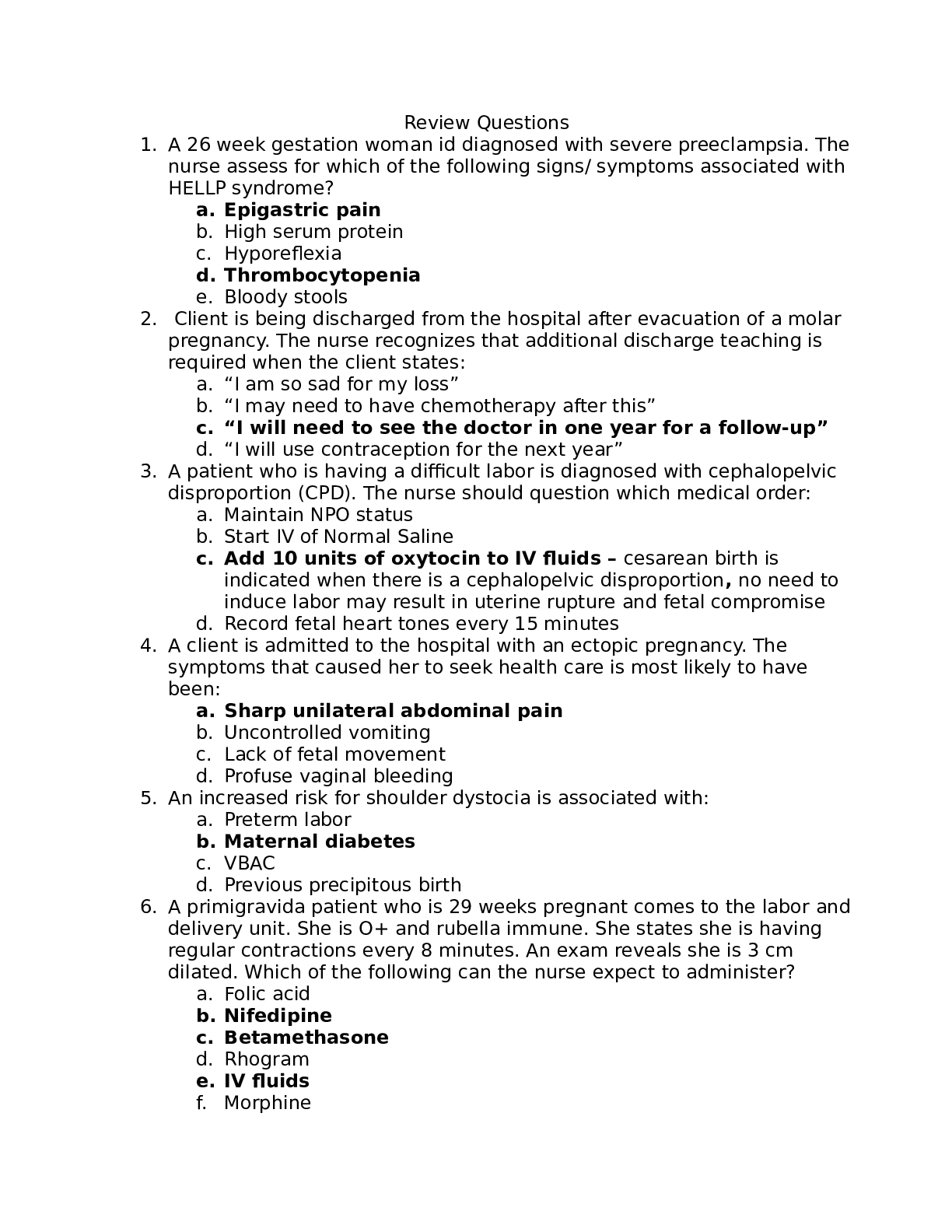
Reviews( 0 )
Document information
Connected school, study & course
About the document
Uploaded On
Apr 07, 2021
Number of pages
15
Written in
Additional information
This document has been written for:
Uploaded
Apr 07, 2021
Downloads
0
Views
33




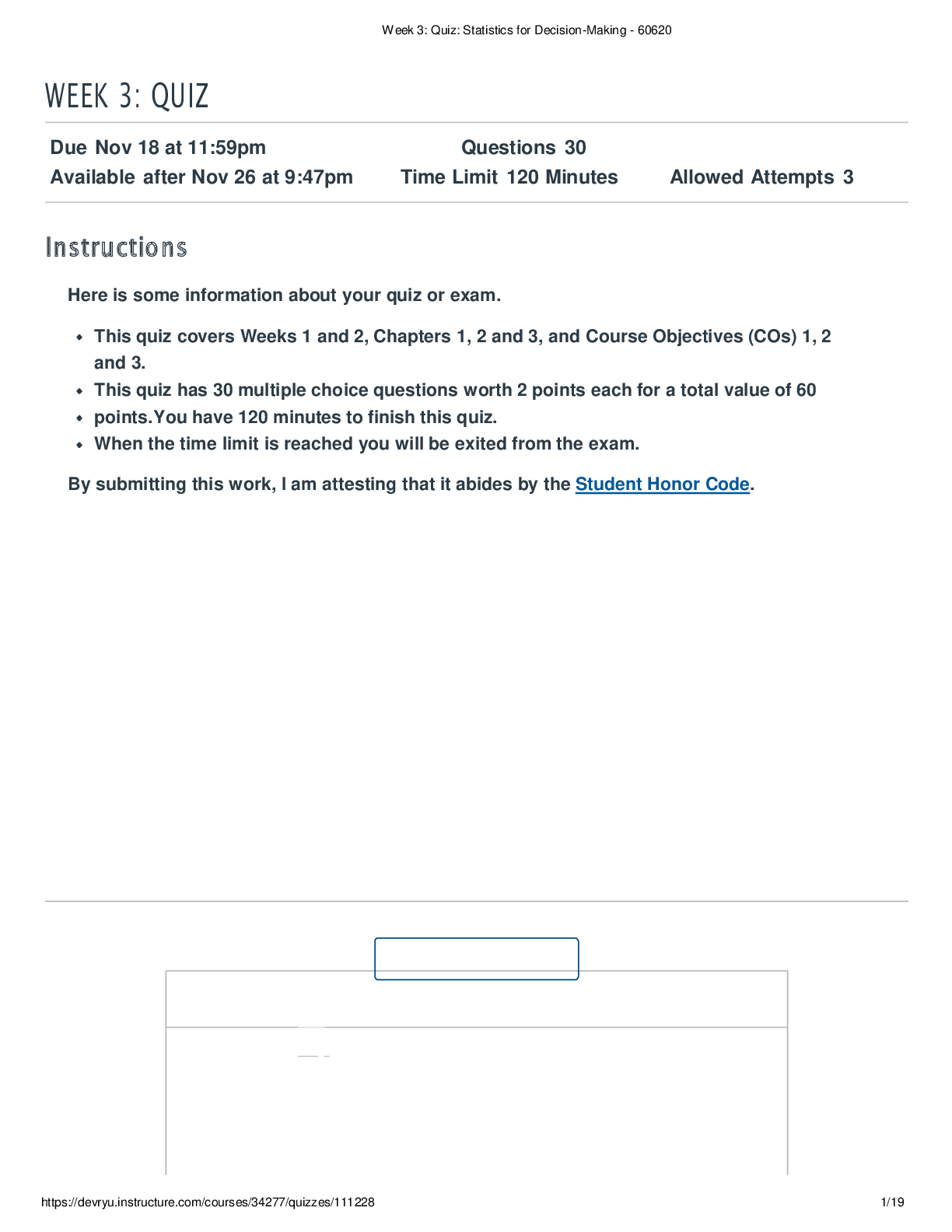

.png)











